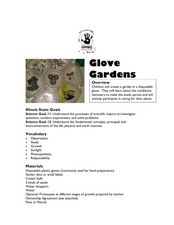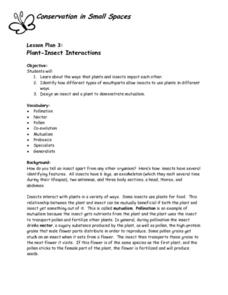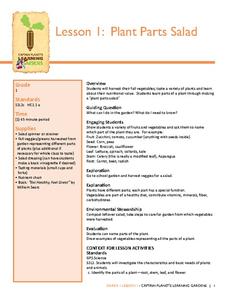Curated OER
Growing a Winter Garden
Second graders listen to planting story, identify vegetables in pictures, and watch teacher demonstrate proper way to plant seeds in soil, and water. Students then plant seeds into their own containers.
Curated OER
Let's Get Carried Away
Learners discover how seeds travel from their parent plants in search of water, sunlight, and nutrients, and conduct experiments in which they note characteristics that encourage seed dispersal by means of wind, water, animal carriers,...
Curated OER
Glove Gardens
Students investigate how seeds sprout. In this scientific inquiry lesson, students make predictions on which seeds will grow the fastest and observe the seeds over a period of time. Observations are recorded into a journal.
Curated OER
The Amazing Tomato
Learners gain an understanding of where our food comes from. In this plant life lesson, students review what plants need for growth and how long it takes them to grow. Learners research which plants it takes to make salsa. Students then...
Curated OER
Plants Multiple Choice Activity
In this plant worksheet, students complete a set of 15 multiple choice questions about plants and their growth. A reference web site is given for additional activities.
Curated OER
Plants Vocabulary Quiz
In this plant vocabulary instructional activity, students draw lines to match 10 plant words with their meanings. Prior knowledge is assumed.
Curated OER
Collecting and Pressing Plants
Students engage in a lesson that is concerned with the study of native plants and classifying them according to a kind. They press them into a journal while identifying them according to species. Students compile the samples into a...
Curated OER
Unit on Developing a Basic Understanding of Plants
Fifth graders study the parts of a plant, their life cycles, and how to care for them in this unit.
Curated OER
Pumpkin Science
Here is a nice instructional activity, which includes some good worksheets, on pumpkins and how they grow. It is an ESL instructional activity designed for beginning and early intermediate students. After listening to some books about...
Curated OER
Conservation in Small Spaces: Plant-Insect Interactions
Students explore ways that plants and insects impact each other, identify how different types of mouthparts allow insects to use plants in different ways, and design an insect and a plant to demonstrate mutualism.
Captain Planet Foundation
Plant Parts Salad
How are vegetables beneficial to a healthy diet? Have kids examine different types of vegetables, such as zucchini, broccoli, and carrots, and determine which parts of the plant they represent. Then, they taste the vegetables as a class....
Captain Planet Foundation
Help a Sister Out: Garden Companions
Explore Native American gardening traditions with a lesson on companion planting. Based on the concept that certain crops grow better when planted near other specific crops, kids research the gardening method with background links and by...
University of Wisconsin
A Rain Garden Year
Pupils become plants in an interpretive play that depicts what happens throughout the seasons in a rain garden. As you narrate, students bloom, flower, and go to seed accordingly. The lesson is first in a series of lessons written for...
Curated OER
Day 5 - Science Plants - germination - growth- What plants do we need to survive?
Young scholars look at the crops of the settlers. In this crop lesson, students discuss why each crop was important to the settlers and how they used it. They plant seeds and track and observe the growth.
Curated OER
What Are Heritage Plants?
Students listen to a story, plant seeds, and study about heritage seeds. They read seed packages for plant needs and sizes, plant seeds. They read story "How Groundhog's Garden Grew" which covers many activities of planting, growing...
Curated OER
What Plants Need
Students plant seeds in milk cartons, over the next two weeks, they watch the plants closely to see how they grow and change. They keep a photo journal to record the growth of the plant.
Curated OER
Growing Seeds Indoors: What is the difference?
In this dicot and monocot seeds worksheet, students read the difference between the two types of seeds and draw a picture, make a poster, and use the internet to find more research on them. Students complete 3 tasks.
Curated OER
Flowering Plants
Pupils conduct online research to investigate gardening and landscaping tips. They determine how they can help beautify their homes and neighborhoods.
Curated OER
Multicultural Literature Lesson Plan The Lotus Seed by Sherry Garland
Sixth graders begin reading "The Lotus Seed" before determining a plant that is a representative of their country or region. They illustrate the plant and write sentences about it and locate the region on a map. Finally, they make a...
Curated OER
Where do Plants Get their Food?
In this where do plants get their food worksheet, students design an experiment that will disprove the idea that plants obtain their food from soil. Students will set up their experiment and design a data table that will record data over...
Curated OER
Salt is Good On Sunflower Seeds, But What About Cypress?
Students record their observations about growing a cypress plant and putting salt in the plant. In this cypress plant lesson plan, students observe and record what is happening as the cypress plant grows. This gives directions for...
Curated OER
Lesson 3: Life Cycle of Brassica Plants
Students investigate the life cycle of brassica plants. In this science lesson, students observe each stage in the life cycle of their plant. Students record their observations and graph the data. Students
Curated OER
Sowing Seeds of the Future
Students explore how to preserve native wild plants and garden crops. In this science lesson, students play the role of botanists and research North American plants. Students create a presentation about their findings.
Curated OER
Edible Plants
Students determine what part of a plant they are eating when they eat different fruits and vegetables, and make collages of fruit and vegetable pictures that are flowers, fruits, leaves, roots, seeds, seed pods, stems and tubers.

























